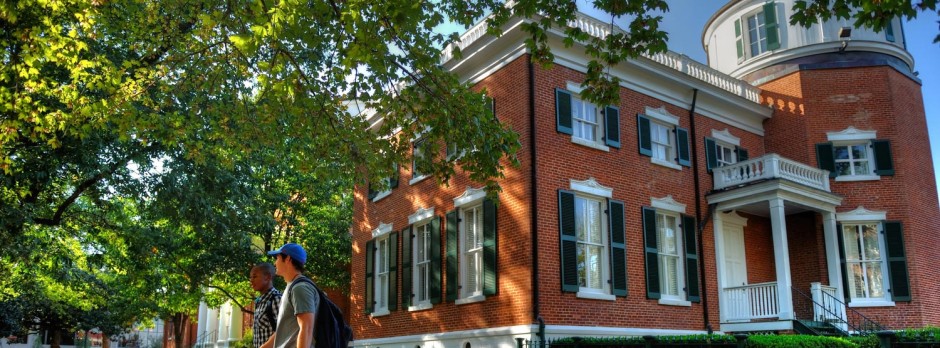Barnard Observatory
Barnard Observatory, named for Frederick A. Barnard, is one of the oldest buildings on the University of Mississippi campus. For a map, click here.
“I have done some work here which will not die with me.” — F.A.P Barnard, 1859
Barnard Observatory is the home of the Center for the Study of Southern Culture and was built by enslaved labour between 1857 and 1859. It is one of three remaining antebellum buildings on campus where, like all of Oxford and the surrounding area, it sits atop ancestral Chickasaw land ceded by force with the signing of the Treaty of Pontotoc Creek in 1837.
Frederick A.P. Barnard, born in Massachusetts in 1809, graduated from Yale before teaching at Hartford Grammar School and the New York Institution for the Instruction of the Deaf and Dumb. With the growing sectional divide over slavery, there was a reluctance of the Southern elite to send their sons to abolitionist Northern institutions and instead a need to establish universities in the South that taught a pro-slavery curriculum, requiring the luring of educators below the Mason-Dixon line. After meeting the president of the University of Alabama in 1837, Barnard accepted a position as the chair of mathematics and natural philosophy in Tuscaloosa.
In 1854, Barnard learned from a former student about an available position as the chair of the chemistry, mathematics, and astronomy departments at the upstart University of Mississippi, then only a decade old. In 1856, Barnard became the university’s first chancellor (the title was changed from president in 1858), and aimed to make the university a national leader in what was then called “experimental science,” favoring observation, experimentation, and scientific inquiry above rote recital. Securing $100,000 from the state legislature for his educational reforms and new scientific equipment, he set his sights on building his monument: a Greek revival observatory, modelled on Pulkovo Observatory in Russia and designed to contain a state-of-the-art barometer and the world’s largest refracting telescope.
A Northerner at a time of great division, Barnard was aware of a need to allay suspicion for abolitionist beliefs and held two enslaved workers, Jane and Nathan, who lived with him and his wife Margaret. On May 12, 1859 while the couple were away from Oxford, student S.B. Humphreys entered his home, beating and raping Jane. Once recovered she identified her attacker to Margaret who relayed it to her husband. A split faculty decision on Humphreys’ guilt kept him from being expelled, but Barnard’s personal letter to his parents lead to his withdrawal and subsequent rejection on reapplication in the following semester. Jane’s story is memorialised in a historical marker outside the front of the building.
Barnard’s decision to take the testimony of an enslaved woman over a white student, in counter to Mississippi law, was controversial and led to his investigation by the board of the university, who ruled him sound on the question of slavery after two days of testimony. It would be a temporary reprieve from his place in the sectional question: with the vast majority of the student body joining the University Greys in the wake of secession and only four students registered for the 1861 semester, the Unionist Barnard resigned as chancellor and returned to the North to teach at Columbia. The Civil War likewise prevented his telescope from ever completing his observatory. Commissioning a Massachusetts company to construct the lens in 1856, it was finished in 1861 but was unable to be dispatched South and remained in its workshop until being auctioned off to Northwestern University in 1863.
During the Civil War the building was used as a hospital for both Union and Confederate troops, surviving the razing of most of Oxford on account of Sherman’s friendship with Barnard. After his departure the building continued to house the Department of Physics and Astronomy with two telescopes, a smaller one that Barnard had acquired around 1856 and a larger one to be the building’s centrepiece (although not to the record size he had wanted), before separate physics and astronomy buildings were each completed in 1939 and the telescopes were moved to Kennon Observatory, where they remain. Barnard Observatory, split into east and west wings, housed Naval ROTC, the official residency of the chancellor, and the Alpha Xi Delta sorority, before the newly founded Center for the Study of Southern Culture found a home its east wing in 1977. By 1986, the Center grew to be the only resident.
Receiving a National Register of Historic Places designation in 1979 and becoming a Mississippi Landmark in 1986, the century-old building of many faces needed architectural renovations. Fundraising $3 million including $600,000 from the NEH, the renovations started in 1989 and completed by 1992, stripping away much of the additional features over the years and returning to Barnard’s original vision of the building. Its west wing accommodates the Tupelo lecture room, host of the series of SouthTalks and the Gammill Gallery of rotating exhibitions. With the university observatory now located in Kennon Observatory, the Southern Foodways Alliance occupies the floor where Barnard hoped his telescope would reside.
Further information:
National Register of Historic Places Nomination Form (September 1977): https://www.apps.mdah.ms.gov/nom/prop/32429.pdf
David Sansing The University of Mississippi: A Sesquicentennial History (March 1999)
Tom Howorth History is Lunch: F.A.P. Barnard: The Man and His Observatory (December 2019): https://www.youtube.com/watch?v=NybhlH5ZivY
Written by Cosmo McGee, Southern Studies Graduate Student

